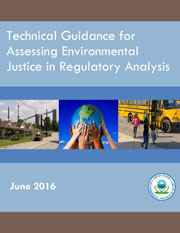Technical Guidance for Assessing Environmental Justice in Regulatory Analysis
- What is the Technical Guidance for Assessing Environmental Justice in Regulatory Analysis (EJ Technical Guidance or EJTG)?
- Why is the EJ Technical Guidance important?
- What topics are covered in the EJ Technical Guidance?
- Who will use the EJ Technical Guidance?
- How was the EJ Technical Guidance Developed?
- Where can I obtain additional information?
What is the Technical Guidance for Assessing Environmental Justice in Regulatory Analysis (EJ Technical Guidance or EJTG)?
The Technical Guidance for Assessing Environmental Justice in Regulatory Analysis (EJ Technical Guidance) is designed to help EPA analysts evaluate potential environmental justice (EJ) concerns associated with EPA regulatory actions. While the EJ Action Development Process Guide issued in May 2015 (Guidance on Considering Environmental Justice During the Development of an Action) provides direction on when EJ should be considered during rulemaking, this latest guidance provides direction on how to do so in an analytical fashion. It directs analysts to assess whether EJ concerns exist prior to the rulemaking and whether such concerns are exacerbated or mitigated for each regulatory option under consideration. The EJ Technical Guidance takes into account EPA's past experience in integrating EJ into the rulemaking process, and underscores EPA's ongoing commitment to ensuring the fair treatment and meaningful involvement of all people with respect to the development, implementation, and enforcement of environmental laws, regulations, and policies.
Why is the EJ Technical Guidance important?
The EJ Technical Guidance makes four main recommendations designed to ensure consistency across EPA assessments of potential EJ concerns for regulatory actions. The recommendations encourage analysts to conduct the highest quality analysis feasible, recognizing that data limitations, time and resource constraints, and analytic challenges will vary by media and circumstance. They are not designed to be prescriptive and do not mandate the use of a specific approach. The recommendations are:
- Analysts should use best professional judgment to determine the combination of quantitative and qualitative analysis that is possible and appropriate for each regulatory action; for regulatory actions where impacts or benefits are quantified, some level of quantitative analysis for EJ is recommended.
- Analysts should integrate applicable questions during the planning and scoping and problem formulation stages of the risk assessment.
- Analysts should follow identified best practices for incorporating potential EJ concerns into regulatory analysis, when feasible and applicable.
- Analysts should consider the distribution of costs associated with implementing a regulatory option from an EJ perspective when appropriate, feasible, and relevant.
What topics are covered in the EJ Technical Guidance?
The EJ Technical Guidance is organized into seven main sections and three appendices.
- Section 1 provides an overview of the guidance.
- Section 2 describes the key definitions used throughout the guidance.
- Section 3 highlights key analytic considerations, including three questions to frame the analysis, data and other analytic considerations, and the four main recommendations for guiding the analysis.
- Section 4 discusses select contributors to and drivers of the uneven distribution of health risks that often occur among communities with potential EJ concerns.
- Sections 5 provides technical guidance on how to incorporate consideration of potential EJ concerns into EPA's human health risk assessment framework during the risk assessment planning phase.
- Section 6 provides analysts with guidance on how to evaluate what level of analysis is feasible (qualitative, quantitative or some combination); the types of information that should be presented and methods that can be used to generate this information; and a discussion of other analytic considerations that could affect the results of the assessment.
- Section 7 provides a summary of research gaps and data needs specific to improving EJ analysis for the Agency.
- The appendices provide a suite of examples. Appendix A lists other EPA resources that may be helpful when conducting risk assessment or economic analysis. Appendix B includes examples of approaches used when considering EJ in exposure and effects assessment. And, Appendix C summarizes information about how EJ has been analyzed and considered in 11 recent regulatory actions.
Who will use the EJ Technical Guidance?
The primary users of the EJ Technical Guidance are EPA analysts, such as economists and risk assessors, who are developing or overseeing the development of analyses to support regulations.
How was the EJ Technical Guidance Developed?
The EJ Technical Guidance was developed by a team of economists, risk assessors and other analysts that was led by the EPA's Office of Policy, Office of Environmental Justice, and Office of Research and Development. Based on currently available, scientifically-appropriate risk assessment and regulatory analysis methods, it underwent external peer-review by a special panel of EPA's Science Advisory Board. Information on the external peer review are available through the SAB website. In addition, a 120 day public comment period was conducted prior to the SAB review.
Where can I obtain additional information?
In May 2015 EPA released the Guidance on Considering Environmental Justice During the Development of an Action. It provides information to rule-writers and decision-makers on when to consider EJ during the Action Development Process, as well as the questions to ask during the process.
In May 2014 the EPA released a new chapter in the Guidelines for Preparing Economic Analyses, Chapter 10: Environmental Justice, Children's Environmental Health and Other Distributional Consideration. The chapter discusses how to consider EJ, children's environmental health and other factors in economic analyses conducted for economically significant rules. Developed to assist EPA economists, the chapter provides an overview of Executive Orders, policies, and other directives that discuss how benefits and impacts of a regulatory action may be distributed across various groups, summarizes relevant economic literature, defines key population groups, offers a suite of methods that can be used to describe distributional effects, and presents emerging issues related to the use of inequality indices.

